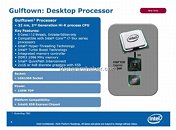Friday, August 7th 2009

Gulftown Seamlessly Compatible with X58 Chipset Platform
Nearly an year away from launch, Intel's 6-core Gulftown processor is creating buzz in the media. The new processor which has already been sampled, and tested, some of its first documentation has been leaked to the media in the form of a slide that lists out some details. To begin with, Gulftown will be the first high-performance processor built on the 32 nm second-generation HKMG process. Intel's first commercial 32 nm based processors are dual-core chips which will sell alongside the much larger 45 nm CPU lineup. Next of-course, is that it has six processing cores with HyperThreading enabling 12 logical CPUs. With TurboBoost, the processor powers down inactive cores and overclocks the active ones, thus boosting performance on single/few-threaded apps while reducing power consumption.
Next up is its integrated memory controller supporting DDR3-1066 memory. The same standard is listed for current Core i7 processors, though they are proven to work at higher memory bus speeds. The part that perhaps matters the most is that the processor is seamlessly compatible with the X58 chipset, is based on socket LGA-1366, and has the same TDP rating as Core i7 900 series processors: 130W. Existing motherboards that handle Core i7 processors are technically capable to handle Gulftown. The processor will only be available in the high-end (enthusiast) category, and according to the latest roadmaps, is slated for Q2 2010.
Source:
DonanimHaber
Next up is its integrated memory controller supporting DDR3-1066 memory. The same standard is listed for current Core i7 processors, though they are proven to work at higher memory bus speeds. The part that perhaps matters the most is that the processor is seamlessly compatible with the X58 chipset, is based on socket LGA-1366, and has the same TDP rating as Core i7 900 series processors: 130W. Existing motherboards that handle Core i7 processors are technically capable to handle Gulftown. The processor will only be available in the high-end (enthusiast) category, and according to the latest roadmaps, is slated for Q2 2010.

38 Comments on Gulftown Seamlessly Compatible with X58 Chipset Platform
We wouldn't be seeing the IPC we are if it's roots were in netburst. Even with HTT disabled, it's IPC is higher then all other current x86 chips out. Netburst failed miserably at ipc, due to it's retarded long and narrow pipelines that favored clock speed over ipc whick took forever to flush in case of a cache miss or prediction error (which was what made it the netburst architecture.) Nehalem does not have long and narrow pipes. Even with todays much improved branch prediction, netburst still couldn't be made this efficient.
And it does not suck at gaming. Where in the hell do you get that conclusion? Just because it doesn't benefit gaming, doesn't mean it sucks at it. Almost all games on the market are gpu limited. The cpu makes no difference to gameplay (within reason, of course).
Netburst had serious leakage and cache miss issues. Nehalem has the leakage and caching issues fixed.
Penryn has 14 stages. Early Netburst processors have 20 stages. Later Netburst processors (Prescott) have 32 stages. Guesstimates put Nehalem at somewhere between 20 and 24 stages.
The SMT capabilties of Netburst were strapped on after they realized how much of the processor sat idle. Nehalem was designed knowing SMT was going to be included so it is a much better implementation.
Nehalem is effectively Netburst done right. Remember, Intel spent over 7 years trying to fix Netburst and never really succeeded.At low resolutions where the CPU is the most important, Nehalem does better. The higher the resolution, the worse Nehalem does compared to Core 2 and Phenom II. I've never found an explaination for this--perhaps a shortcoming of QPI.
And all the tests I've seen show i7 slightly ahead at higher resolutions in most games, with only a couple of exceptions. Even tho i7 pulls ahead slightly, it makes no real difference anyway, as the playability remains the same between all the chips at high res gaming. Thus, no modern chips actually "suck" at gaming.
Shall we stick a percentage on how alike Pentium 3, Pentium 4, Core 2, and Core i7 are? It might be fun. :D
Maybe MCM... but multi-core really isn't an architectural feature.
I'm down to just x86-64/x86 now. :(